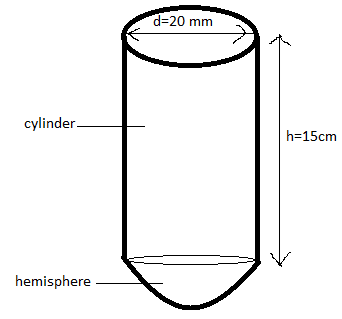
A test tube has a diameter 20 mm and height is 15 cm. The lower portion is a hemisphere. Find the capacity of the test tube. (π = 3.14)


Answer
600.3k+ views
Hint: Divide the test tube into a hemisphere and a cylinder. Find both the volumes and add them to find the capacity of the test tube. The capacity of the test tube is nothing but the volume of the test tube. Convert the measurements into the same units.
Complete step-by-step answer:
Given Data
Diameter d = 20 mm = 2 cm (1 cm = 10 mm)
Radius r = 10 mm = 1 cm $\left( {{\text{r = }}\dfrac{{\text{d}}}{2}} \right)$
Let us consider the volume of the cylinder as $V_1$ and volume of the hemisphere as $V_2$.
Volume of a cylinder = 2πrh (where r – radius and h – height)
And, Volume of hemisphere = $\dfrac{2}{3}\pi {{\text{r}}^3}$(where r – radius)
Now $V_1$ = 2 × 3.14 × 1 × 15 = 94.2 ${\text{c}}{{\text{m}}^3}$
$V_2$ = $\dfrac{2}{3} \times 3.14 \times {1^3} = {\text{2}}{\text{.093c}}{{\text{m}}^3}$
Now volume of test tube = $V_1$ + $V_2$
$ \Rightarrow {\text{V = 94}}{\text{.2 + 2}}{\text{.093 = 96}}{\text{.293c}}{{\text{m}}^3}$
The capacity of is the volume of the test tube which is ${\text{96}}{\text{.293c}}{{\text{m}}^3}$
Note: The pivotal part of the problem is to break down the given figure into known figures with known formulae. In this problem the volume of the test tube is unknown but when it is broken down into a cylinder and a hemisphere whose volumes are known the problem becomes pretty straight forward.
Complete step-by-step answer:
Given Data
Diameter d = 20 mm = 2 cm (1 cm = 10 mm)
Radius r = 10 mm = 1 cm $\left( {{\text{r = }}\dfrac{{\text{d}}}{2}} \right)$
Let us consider the volume of the cylinder as $V_1$ and volume of the hemisphere as $V_2$.
Volume of a cylinder = 2πrh (where r – radius and h – height)
And, Volume of hemisphere = $\dfrac{2}{3}\pi {{\text{r}}^3}$(where r – radius)
Now $V_1$ = 2 × 3.14 × 1 × 15 = 94.2 ${\text{c}}{{\text{m}}^3}$
$V_2$ = $\dfrac{2}{3} \times 3.14 \times {1^3} = {\text{2}}{\text{.093c}}{{\text{m}}^3}$
Now volume of test tube = $V_1$ + $V_2$
$ \Rightarrow {\text{V = 94}}{\text{.2 + 2}}{\text{.093 = 96}}{\text{.293c}}{{\text{m}}^3}$
The capacity of is the volume of the test tube which is ${\text{96}}{\text{.293c}}{{\text{m}}^3}$
Note: The pivotal part of the problem is to break down the given figure into known figures with known formulae. In this problem the volume of the test tube is unknown but when it is broken down into a cylinder and a hemisphere whose volumes are known the problem becomes pretty straight forward.
Recently Updated Pages
Master Class 12 Business Studies: Engaging Questions & Answers for Success

Master Class 12 Economics: Engaging Questions & Answers for Success

Master Class 12 English: Engaging Questions & Answers for Success

Master Class 12 Maths: Engaging Questions & Answers for Success

Master Class 12 Social Science: Engaging Questions & Answers for Success

Master Class 12 Chemistry: Engaging Questions & Answers for Success

Trending doubts
What is meant by exothermic and endothermic reactions class 11 chemistry CBSE

Which animal has three hearts class 11 biology CBSE

10 examples of friction in our daily life

One Metric ton is equal to kg A 10000 B 1000 C 100 class 11 physics CBSE

1 Quintal is equal to a 110 kg b 10 kg c 100kg d 1000 class 11 physics CBSE

Difference Between Prokaryotic Cells and Eukaryotic Cells




